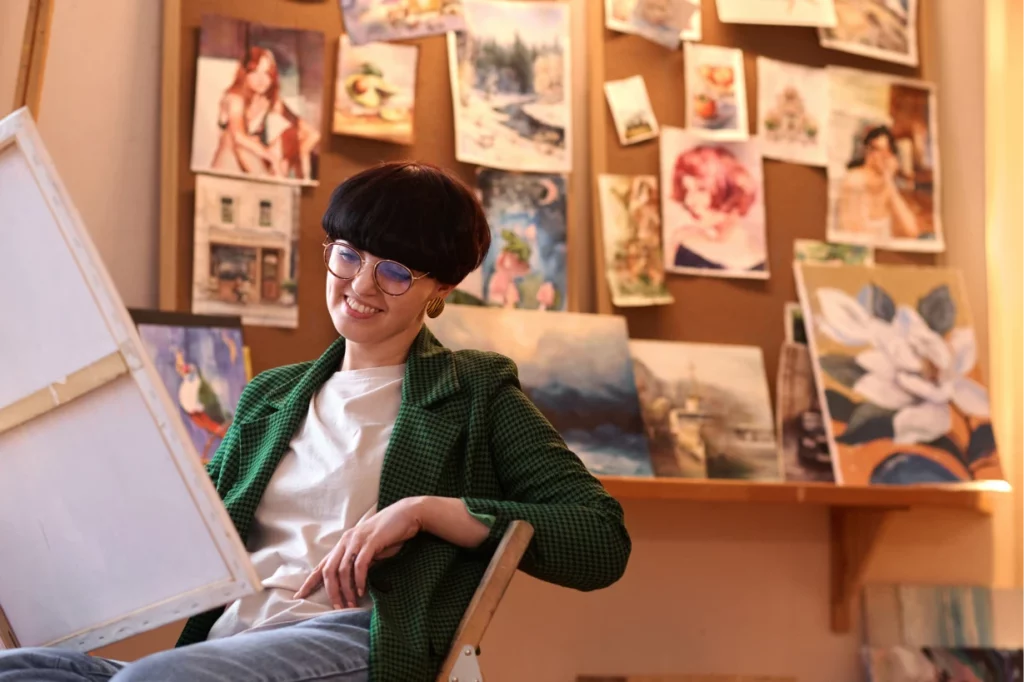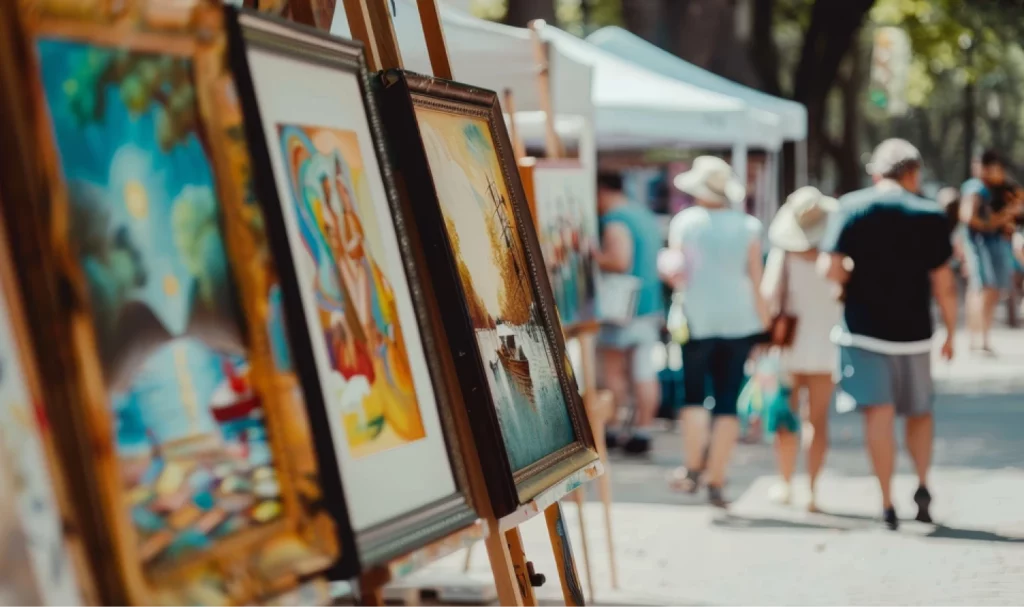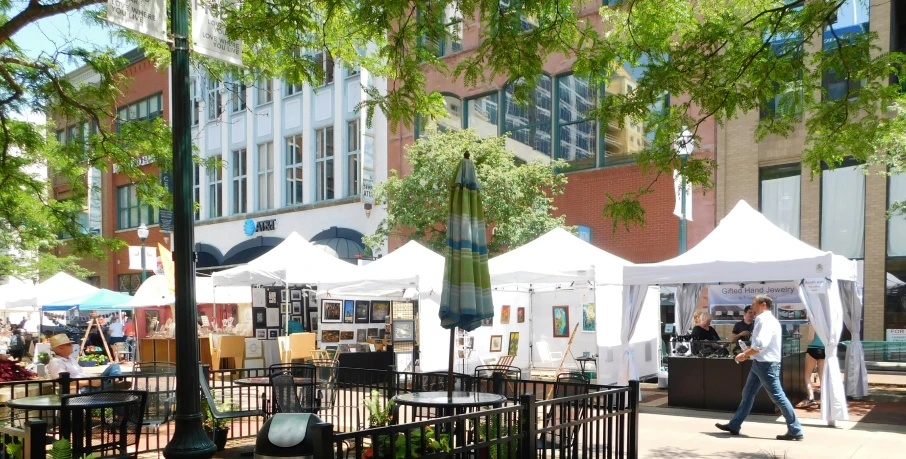Whether you’re an emerging artist or you’ve been selling at local shows for years, large events like juried art festivals are great opportunities to showcase your work and elevate your business. We asked the experts to share their experiences growing an art business through the festival circuit, and we’re sharing that advice (and more) with you!
Feel confident applying to big shows, pricing your products, and closing more sales with insider tips from ACT Insurance’s webinar on Artists & Crafters Best Practices for Working with Large Events, hosted by Kyle Porter and featuring:



What Artists Need to Know About Selling at Festivals
Often, the secret to getting ahead is getting started. The same rings true for artists who feel like they’re not quite ready to sell their unique creations at big fairs, shows, and other events.
Getting the show on the road, sometimes literally, is the first step to growing your business into a successful art venture. The best part? You’re never alone in this endeavor. Fellow artists are happy to give you advice and share their experiences — this webinar is proof.
Many artists and crafters don’t know that you can reach out to event organizers like our partner Howard Alan Events for tools, tips, and critiques that boost your chances of being accepted into juried shows and making more sales.
“I entered as an emerging artist at a local art festival and didn’t feel like I was good enough or that anybody would like my unique artwork,” Ruffin expresses. “After my first day there, I was encouraged by fellow artists who gave me great advice to keep going, keep trying. Two weeks later, I jumped into a Howard Alan Event, and it changed my life.”
Lastly, and most importantly, you’re attending these events not just to sell your beautiful work but to connect with customers. These connections show the true value of your craft, turning shoppers into loyal collectors who remember you from one event to the next.
Watch the Webinar to Get the Full Picture
Check out these key takeaways from the webinar to help you thrive at your next craft show or art festival:
- How to apply and get accepted (5:37): Professionalism paves the path to acceptance. Treat your application like a resume and the photos of your art and booth like a gallery.
- Designing a professional and inviting booth (14:52): Taking a less-is-more approach transforms your booth setup into a curated gallery where guests feel welcome to browse and buy.
- Planning inventory for large shows (20:35): Produce as much as you can before the show to fully stock your display and keep backups in your car to fill in empty spaces after you’ve sold out.
- Pricing artwork and handling negotiations with confidence (24:40): Know your worth, and be confident with the way you state your price – you never want to undersell yourself and regret it later.
- Marketing strategies and pre-show promotion (35:30): Daily social media posts, email blasts, and free promotion tools from event organizers draw in new and past customers.
- Talking to customers without being pushy (41:07): Avoid the sales talk and welcome your customers with comfortable conversation, giving them time and space to fall in love with your product.
- Building personal connections to sell more art (46:06): Fostering a sentimental connection by asking customers why they love a piece makes your art more valuable and easier to sell.

How to Get Into Large Arts & Crafts Shows
As an art show director, Laurent evaluates applications based on their professionalism, quality of work, and overall display.
With hundreds of new exhibitors each year, the chances of getting accepted are high, but you must read the show’s rules. If you use drape tables and the event doesn’t allow them, don’t apply with those photos. Instead, upgrade your display or see if the event offers tent rentals.
Most juried art show applications ask for:
- Your contact and business information
- An artist’s statement
- High-quality images of your work
- Artwork details like medium, dimensions, and pricing
- Recent photos of your booth
- Your portfolio shows a consistent style
- Your Certificate of Insurance (COI)
- Application fee
If you don’t have a website or your lighting isn’t the most professional, it’s still okay to apply. Every show is a learning opportunity. Don’t be afraid to reach out to the event organizer for advice, especially if you’re struggling to get accepted.
“[Artists] will also send in their information to the office and ask it to be critiqued, so that way they know what they have to do to correct their displays to make the application run through,” Laurent says.
The bottom line: Large festivals can be competitive, but it’s not impossible to get in. Put your best foot forward and start by searching for local shows or choose from the top arts and crafts events in your state.
👥 Pro Tip: Joining online community pages, like Facebook groups for artists, is an excellent way to network with others, get ideas for your booth display, and discover new festivals.
What Event Organizers Look For In A Booth Display
One of the biggest mistakes exhibitors make is filling every square inch of space instead of keeping it simple. Think of your booth like your own mini art gallery. It should be well-curated with pieces that complement each other.
“You’re giving people too many choices,” Reinheimer explains. “If you go into a museum or a gallery, typically there’s one sight line of work across the walls. And that’s a good place to start your booth design is to simplify it and only hang the best of the best.”
The best displays invite customers to look at every piece individually, whether it’s a necklace, a landscape painting, or wooden bookends. A few art and craft show booth ideas for standing out are:
- Use vertical space: Tall booths, wall displays, and tiered stands maximize your space and allow customers to see your products from a distance.
- Place print bins strategically: Print bins are great for customers on a budget who still want to enjoy your work. Place them in the back, so they have a chance to see larger pieces and make sure they aren’t in the way of the flow of traffic.
- Avoid displays on the ground: Showing respect for your own work encourages customers to respect it as well. Don’t let your pieces lean on the ground for lack of room; instead, use risers or shelves.
- Use clever branding: Your booth reflects your brand. Incorporate branding elements that also work as marketing strategies, like signage with QR codes to your website and social pages.

What to Say to Customers: Simple Scripts to Seal the Deal
Selling art and crafts at large events isn’t just about having stellar products — it’s about the conversations you have with buyers. How you engage with customers, talk about your prices, and guide them toward higher-value purchases can make or break your sales.
Approaching Customers in Your Booth
If you usually open with, “If you have any questions, let me know,” this advice is for you. Instead, introduce yourself as the artist so shoppers immediately know who to speak to. Instead of pushing for a sale or standing back completely, start a dialogue.
“A good way [to talk to customers] is to welcome them. Say, ‘Hello. How are you? Are you enjoying the festival today? Have you seen any cool art?’ Just start a conversation. You don’t have to go in with a hard sell,” advises Ruffin.
💡 Pro Tip for Introverts: Try Mirroring
Feeling awkward? Introverts can make approaching customers easier by reflecting their energy. According to Reinheimer, this technique helps you both feel more comfortable and makes the interaction flow naturally.
Handling Discounts and Negotiations Gracefully
Pricing your art fairly isn’t just math — it’s a statement that your work has value, and people will rise to meet that confidence. When negotiating, stand firm in your price but recognize the potential for a sale.
If a customer asks about your pricing, Laurent recommends responding with something like, “This is a one-of-a-kind piece in [style details]. It is entirely handmade using [materials]. This particular piece is [price], but I offer it in multiple sizes. It includes [shipping, delivery, packaging, etc.] I can also do custom orders or commissions.”
This helps you work with customers on a budget and maintain your value. Sometimes, it’s okay to offer a discount, especially for returning customers or people buying multiple pieces.
The Importance of Connection
Fostering connections between your customers and your art makes it feel more authentic, which leads to long-term relationships and sustainable business. To start this process, let the customer lead the interaction.
“A big thing with talking to people is to let them tell you what they like,” Laurent says. “Let them gravitate toward it and then try to introduce them to it.”
Once a customer shows interest, deepen the connection by discussing the meaning behind your creation. For instance, ask them why the piece resonates with them or if it brings up a specific memory.
“The connection with the artists, for me at least, helps to sell the piece more than the piece itself,” Ruffin says. “Once they know the meaning and it means something to them, too, that’s everything.”
⭐The #1 Trick to Upselling at Art Festivals
Big pieces can feel like big decisions — especially if a customer worries about carrying them. The solution? Make it easy. Offer to bring it to their home so they can see it in their space, or hold it until the end of the festival. A little extra service often turns hesitation into a happy “yes.”
Marketing Strategies That Actually Work
Every person who stops at your booth is a potential fan — even if they don’t buy today, they’ve discovered you. By making consistent appearances, Reinheimer notes, “You’re planting these seeds with collectors that will flourish in the future.” The following strategies will help you cultivate those seeds before, during, and after every event.
- Daily social media countdown: Post engaging content every day leading up to the event to boost your visibility, drive online engagement, and maximize show turnout.
- Activate your email list: Your existing customer list is gold. Send targeted email blasts reminding subscribers who you are, where you’ll be, and when.
- Leverage organizer marketing: Actively connect with the event’s marketing staff (like those at Howard Alan Events). They often offer free promotional tools and repost exhibitor content, instantly expanding your reach.
During and Post-Show Strategies (Maximize Connection)
- Network with other artists: View every event as a chance to build professional rapport. Exchange contact info, gather advice from experienced artists, and tap into potential new customer circles.
- Prioritize post-show follow-up: Capture emails and comments during the show, then follow up afterward. This vital step builds trust, nurtures relationships, and secures post-show sales.
- Capitalize on slow shows: Don’t let low sales discourage you. That booth fee is still cheaper than any marketing campaign. Hundreds of people still saw your work, took a card, and created valuable long-term leads who may call or order months later.
Grow Your Business with ACT
Every great artist once set up their first booth. Every sale starts with one conversation. And every big win begins with showing up. ACT supports artists in every stage of their journey by removing the “what ifs” so you can grow with confidence.
Insurance coverage is more than a ticket into your next festival — it shows professionalism and builds trust with event organizers. Plus, protecting your business gives you peace of mind so you can focus on what matters most: creating and selling your art.
Common Questions About Best Practices for Large Art Festivals
How do I decide whether to apply for a craft show or art festival?
To decide between a craft show or an art festival, consider your product and business maturity.
Craft shows are generally a better starting point for new art businesses to develop their booth and product line. In contrast, fine art festivals are more competitive and focus on original works of art.
If you’re not sure, contact the show director of a specific event to determine the appropriate category for your creations.
Do I need insurance to sell at art shows?
Yes, you need insurance to sell at art shows, craft fairs, and festivals. Most event organizers ask for a Certificate of Insurance (COI) to secure your spot in the show. This also provides financial protection for your business against unexpected accidents, like a customer getting hurt or damage caused by your display to another vendor’s property.
Should I include price tags on your work?
Yes, most artists prefer tagging their work. Making your prices obvious and accessible adds transparency, making it easier for customers who hesitate to ask about prices.
On the other hand, some fine artists don’t include price tags because they’d rather talk to the customer about what makes the piece valuable.
What sells best at large art festivals and craft fairs?
The best-selling items at large art festivals and craft fairs are typically a mix of small, affordable impulse buys and larger, standout signature pieces.
Small prints, stickers, and jewelry provide an entry point for customers on any budget, while larger, more valuable pieces like original paintings represent your best work. Offer a mix of both categories to maximize sales opportunities across all budgets.


